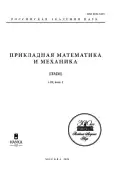High-Performance Numerical Method for Searching the Effective Thermal Conductivity of Media with Inhomogeneous Macrostructure
- Authors: Zvyagin A.V.1, Udalov A.S.1,2
-
Affiliations:
- M.V. Lomonosov Moscow State University
- Scientific Research Institute for System Analysis RAS
- Issue: Vol 89, No 1 (2025)
- Pages: 128-135
- Section: Articles
- URL: https://journals.rcsi.science/0032-8235/article/view/303581
- DOI: https://doi.org/10.31857/S0032823525010093
- EDN: https://elibrary.ru/BNYXRT
- ID: 303581
Cite item
Abstract
When solving engineering problems, it is often necessary to know the physical properties of porous media with complex internal structure. In this paper we propose a technique for numerical modeling of heat conduction of this kind of bodies including non-conducting circular inclusions. This technique allows to calculate temperature fields and heat fluxes, as well as other parameters necessary for applications. One of such parameters demanded by practice is the effective thermal conductivity, which depends on the volume content of thermally insulated pores and their mutual location. The basis of the above studies is the indirect boundary element method proposed in this paper, based on pre-calculated analytical solutions, on which the decomposition is performed. In order to verify the developed methods, a comparison with the results of other authors is given in the paper. It showed a fairly good agreement.
About the authors
A. V. Zvyagin
M.V. Lomonosov Moscow State University
Author for correspondence.
Email: zvsasha@rambler.ru
Russian Federation, Moscow
A. S. Udalov
M.V. Lomonosov Moscow State University; Scientific Research Institute for System Analysis RAS
Email: udalets@inbox.ru
Russian Federation, Moscow; Moscow
References
- Braginsky L., Shklover V., Witz G., Bossmann H.-P. Thermal conductivity of porous structures // Phys. Rev. B, 2007, vol. 75(9).
- Smith D., Alzina A., Bourret J. et al. Thermal conductivity of porous materials // J. Mater. Res., 2013, vol. 28(17).
- Kachanov M., Tsukrov I., Shafiro B. Effective moduli of solids with cavities of various shapes // Appl. Mech. Rev., 1994, vol. 47.
- Kiradjiev K. B., Halvorsen S. A., Van Gorder R. A., Howison S. D. Maxwell-type models for the effective thermal conductivity of a porous material with radiative transfer in the voids // Int. J. Therm. Sci., 2019, vol. 145.
- Klemens P. G. Thermal conductivity of inhomogeneous materials // Int. J. Thermophys., 1989, vol. 10, pp. 1213–1219.
- Sevostianov I., Kachanov M. Elastic and conductive properties of plasma-sprayed ceramic coatings in relation to their microstructure: An overview // J. Therm. Spray Technol., 2009, vol. 18, pp. 822–834.
- Shafiro B., Kachanov M. Anisotropic effective conductivity of materials with nonrandomly oriented inclusions of diverse ellipsoidal shapes // J. Appl. Phys., 2000, vol. 87(12), pp. 8561–8569.
- Wang Z., Kulkarni A., Deshpande S., Nakamura T., Herman H. Effects of pores and interfaces on effective properties of plasma-sprayed zirconia coatings // Acta Mater., 2003, vol. 51, iss. 18, pp. 5319–5334.
- Zvyagin A. V., Udalov A. S. A displacement discontinuity method of high-order accuracy in fracture mechanics // Moscow Univ. Mech. Bull., 2020, vol. 75, pp. 153–159. https://doi.org/10.3103/S0027133020060060
- Zvyagin A. V., Udalov A. S., Shamina A. A. Boundary element method for investigating large systems of cracks using the Williams asymptotic series // Acta Astronaut., 2022, vol. 194, pp. 480–487.
- Zvyagin A. V., Udalov A. S., Shamina A. A. Numerical modeling of heat conduction in bodies with cracks // Acta Astronaut., 2023, vol. 214, pp. 196–201.
- Florence A. L., Goodier J. N. Thermal stresses due to disturbance of uniform heat flow by an insulated ovaloid hole // ASME. J. Appl. Mech., 1960, vol. 27(4), pp. 635–639.
Supplementary files









